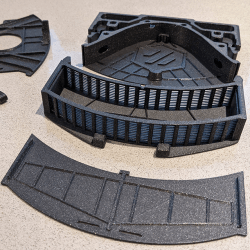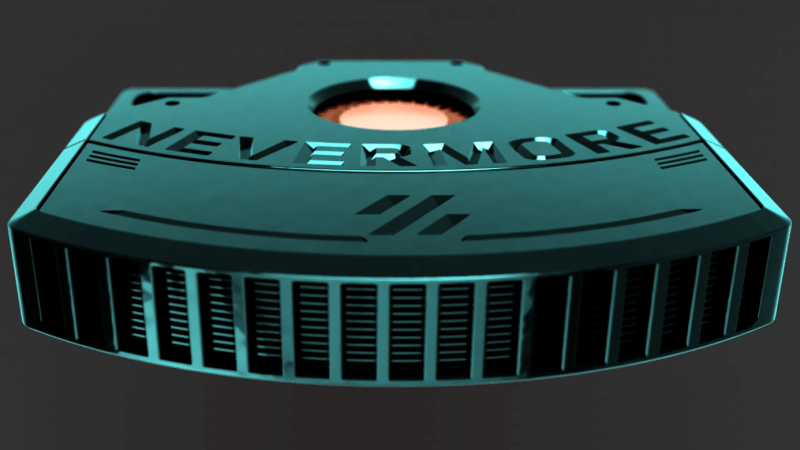What happens when an air filter for 3D printers gets designed by engineers with a passion for function, a refusal to compromise, and a desire to do without bad smells or fumes? You get the Nevermore, a design for a recirculating active-carbon filtration system to deal with VOCs (volatile organic compounds) from 3D printing.

The Nevermore Micro (and larger Nevermore Max) were originally intended to complement the Voron 3D printer design, but are made such that they can be used with just about anything else. These filters use 3D-printable parts, and are designed to be easily filled (and refilled) using bulk-activated carbon instead of some kind of proprietary pre-packed filter like most commercial offerings. The Voron project is all about a printer without compromises, and the Nevermore comes from that same design ethos.
A Nevermore filter sits inside the build chamber, and works by recirculating air inside while passing it through the activated carbon. The idea is that by concentrating on dealing with the problem at the source inside a relatively small build chamber, one doesn’t need a lot of airflow. A small recirculating air filter can do the job efficiently, though for best results, the build chamber should be as sealed as possible.
One interesting caution is that it seems not all activated carbon is the same, and it is absolutely crucial to use only acid-free, steam-activated (not acid-washed) carbon in a recirculating filter like the Nevermore. There are horrifying photos of oxidized metal surfaces resulting from using acid-residue carbon, some of which took only minutes to occur. Thankfully, there are pointers to trusted sources for the known-good stuff.
It’s known that 3D printing results in chemical and particle emissions. These differ significantly depending on both material and type of printer, but it’s enough of an issue to warrant attention. One deals with particulates with something like a HEPA filter, but VOCs require a carbon filter. This is where the Nevermore comes in. Active carbon filters will wear out simply from exposure to the air, so if one is serious about cleaning VOCs when printing, it is definitely worth looking into bulk carbon with a design like the Nevermore.
















What a fantastic idea. Thank you for pointing this out to community!
Anyone have experience with LCD SLA resin 3D printers? How much VOCs do they give off and are they dangerous? Can I run a LCD SLA resin 3D printer in a closed room safely with an acceptable level of odor?
The fumes are dangerous in high concentrations, so you shouldn’t run a resin printer in an unventilated space unless you have a filter. That said, after getting the battery powered activated charcoal filters for my Elegoo Mars 2, it no longer has any detectable odor while running, so the filters definitely work.
…for the compounds you can smell.
[Narcopolypse], thanks for the reply.
Depends on the resin. The water washable stuff isn’t very smelly, but some of the other stuff like siraya tech Blu stink a lot. A bathroom style vent fan is usually enough to keep it under control, but this may be a way better solution…
@Mbc said: “…other stuff like siraya tech Blu stink a lot.”
I didn’t even know about Siraya Tech Blu.[1] Thanks for the info. Wow, fifty bucks per kg with free shipping & returns.[2] I need to figure out some form of exhaust solution.
1. SIRAYA Tech
https://siraya.tech/
https://siraya.tech/collections/products/products/blu-tough-resin-by-siraya
2. Siraya Tech Blu 3D Printer Resin Tough Resin 3D Printing with High Toughness Resolution Strong and Precise Resin 3D Printer 405nm UV-Curing Rapid Resin for LCD DLP 3D Printer (Emerald Blue, 1kg) 4.6 out of 5 stars 914 ratings $49.95
https://www.amazon.com/dp/B089SLXDFH/ref=twister_B07X84C2FW
Will this work with resin printers as well?
Activated carbon does not have a long service life unless the bed is significantly large or the VOC load is relatively small. Has anyone analyzed the carbon bed for VOC breakthrough for service life? If the purpose is VOC removal and considering dangerous levels can exist without odor, it is exceptionally important.
The Nevermore designer recommends to swap out the charcoal every month. Half of the filter is a “cartridge” that is held in place by magnets and can easily serviced.
The Max version has 4 removable “nets” that can be swapped out independently.
This is an awesome project. Major kudos to the author here. I’ve been using this for my lightly used fully enclosed printer for over a year. Works great. You can’t tell you’re printing ABS.
One warning – and the designer goes through this. Some cheap bulk carbon is acid washed. So always check to see if it’ll rust a piece of metal before putting it in your printer.
I need to get my head around this whole aspect of 3D printing
What air filter do you recommend during the print of a Nevermore air filter?
Your back yard. And yes, you were funny.
Nice. It sounds like it would be a great addition to look into for the fully sealed [gd0105] considering that the git repo says that 6 passes removes 99% of compounds. l still plan to have a ventilation port and a VOC sensor so that I can collect data and vent the air if it isn’t clean enough or maintenance costs are too high.
Hey, my project is in a similar vein, the open source 3d printable energy recovery ventilator. It provides fresh air without the heating problems. One of my Beta testers is using it to renoce the dunes associated with resin printing.
I submitted it to jackass but they ignored me. However it was in an arrest stage then so maybe it’s for the best. I expect things will be better after it is more developed.
This seems to be a bit of a word salad, or is it just me?
Can’t tell if this was a lot of auto correct sabotage, or a robot pretending to be human.
It kinda makes sense if you assume the writer was using autocorrect and swiping on mobile in a hurry. Sub these words:
Renoce -> remove
Jackass -> hackaday
Arrest -> test(?)
I’m not so happy about the mapping of “jackass” to “hackaday”…
I’d much rather use one of the many designs that take existing mass produced filters (e.g. the large flat ones intended for PAPRs like the versaflo) that have to pass QC – and have stackable prefilters to remove large chunks and fine particulates before the airflow meets the activated filter – than assembling filters myself.
It is so good to see another product with a decent volume of carbon. The 3D printing industry definitely needs solutions like this for harmful byproducts of the printing process. I was lucky enough to find OdourCube modular air purification system a few months after I started printing. They also have a HEPA filter option for those who can’t vent outside. However, seeing more people becoming aware of the problem and trying to solve it is great.
Question, that maybe someone smarter here can answer.
An electronics friend and I were talking about this, and he asked why not use a soldering fume extractor? They can be found or made cheap, and the charcoal filter panels are also easy to find and cheap. If it’s in an enclosure, it can perform multiple passes easily.
I thought about it and his point seems valid, but I admit I don’t know enough to say it’s a good option or not, but it seems reasonable.
Making no claims to be smarter here, but I have investigated this a bit recently. Here is my understanding/speculation.
A soldering fume extractor would probably do some of the work just fine assuming you could fit one into or onto an enclosure, but the charcoal filters still have the same issues that they have in any other application; They “fill up” and need replacement too quickly. Presumably, the pellets last much longer since they have a much greater surface area… (But maybe not that much longer?)
Also, in the Nevermore docs they go into a fair bit of detail on the optimum porosity for the carbon pellets being sourced and used for the project. I would wager the solder fume filters are not particularly ideal for the job and would leave too much of the nastiness unfiltered.
I can see how the Nevermore Micro and Nevermore Max filters could be incredibly useful, not only for Voron printer users but for anyone who wants to improve their 3D printing environment. It’s refreshing to see innovation and practicality come together in a design like this.
“It’s great to see how a relatively simple air filter like the Nevermore can be so effective in improving the air quality within a build chamber. I had no idea that using the wrong kind of activated carbon could cause such damage so quickly! The emphasis on using acid-free, steam-activated carbon is crucial for preventing corrosion.
https://www.alwayshonestair.com
Ex-military engineers? It looks like a Claymore mine.